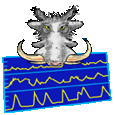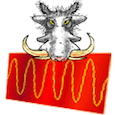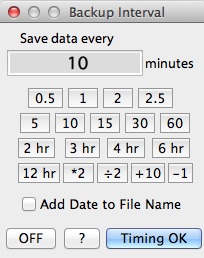SAVE DATA AS... Saves
recorded data to a disk file. This is only available for chart data
and is equivalent to the 'Save data and return' button on the Options window.
WARTHOG BINARY FORMAT When
this is selected, data files will be saved in the default binary format.
Binary files are relatively small, contain comments and header data, and
are saved and loaded very rapidly (see the file formats
page). The icons for binary chart and scope files are:
chart file: scope
file: scope
file: 
ASCII TEXT FORMAT When
this is selected, data files will be saved in text format. This is
a much slower and more bulky method than binary storage, but these files
are more easily created and read by other programs. Scope files
start with the sample interval in seconds and consist of a single 'column'
of voltage values separated by 'returns'. Chart files start
with a list of variable names. The first column is the elapsed time
in seconds, and the remaining columns (separated by tabs) contain the different
variables. Note: comments and other header
data are NOT included in ASCII files; you must use the binary
file format to save these data.
SABLE EXPEDATA FORMAT This
option allows data to be saved in the standard
format used by the Sable Systems
acquisition and analysis package that runs on Windows computers. 'ExpeData' is an expanded version of the older SSCF format.
Expedata and SSCF are binary formats (the IEEE floating-point standard) that are compact
and fast. Sable-format files can be saved almost as quickly as Warthog binary
files. SSCF files contain sample interval data, comments (a maximum
of 240 characters), and start date and time information -- but they lack
channel labels and the other header data that are standard in Warthog files. ExpeData files do support channel labels, voltage conversion data, and some other content.
 ExpeData files
can be read by LabAnalyst, as well as by Sable software on PCs.
LabHelper can also create SSCF files. If
you save files in ExpeData format (from either LabAnalyst or LabHelper),
they will appear (on a Macintosh) with their own special icons in macOS: ExpeData files
can be read by LabAnalyst, as well as by Sable software on PCs.
LabHelper can also create SSCF files. If
you save files in ExpeData format (from either LabAnalyst or LabHelper),
they will appear (on a Macintosh) with their own special icons in macOS:
The way time information is stored in SSCF differs from they way it is stored in ExpeData (the former stores the time data acquisition started and the latter stores the time when it ended). Under some conditions, this might produce timing errors in analysis; for example a file stored in ExpeData format that is read by a program that assumes it is SSCF will result in an apparent time shift equivalent to the duration of data acquisition.
|
TIMED DATA SAVES ⌘T
This option sets up an automatic backup function during data acquisition
runs, which helps safeguard data from program or system crashes, power failures,
and other potential catastrophes. At very high sampling rates and
short acquisition periods, automatic backup is of limited  utility (and can actually slow your acquisition speed), but
it can be a lifesaver if you need to sample over long periods -- especially
if the computer must be left unattended. utility (and can actually slow your acquisition speed), but
it can be a lifesaver if you need to sample over long periods -- especially
if the computer must be left unattended.
To turn on automatic file saving, you need to specify the 'backup interval"
between saves. Obviously, the shorter the interval, the greater the
protection. However, it takes some time to save data (not much if
you are saving in binary format), and at high sample rates and large sample numbers (big files) this can slow
acquisition. The LabHelper default is to use a saving interval
equal to 50% of the expected acquisition period (i.e., the sample interval
times the maximum number of samples), or 30 minutes, whichever is smaller.
You can use the window shown at right to specify any backup interval, or
to switch off automatic backup.
If automatic file saving is operating, a gray menu ("backup ON")
appears, and as backups occur this menu is incremented (i.e., "backup
1", then "backup 2", etc.). The data are
saved in the current folder. By default they are named "backup file"
and (optionally) have the current date appended (i.e., "backup file
10/10/2019"). Although 'Backup' is the default, when you are asked for a backup file name, you can chose any name you like. As a safety precaution, LabHelper stores TWO backups, one of which is always called "Primary backup.whog". Sequential backups will
overwrite each other, but if the date is appended a new backup name will
be used when the date changes at midnight.
If acquisition concludes normally, you can save the complete set of data
under any name you wish, and the backup file(s) can be disposed of.
BACKUP FILE NAME ⌘B
If you are using the 'Timed data saves' option, you can select
the name for the backup file. If a file with that name already exists,
you will be warned.
LOAD
PREFERENCES Allows
loading of a preferences file containing general parameters such
as default screen colors and user-specified voltage conversions. This
is not the same as a setup file, which contains specific channel,
screen format, and external device information. By creating a number
of different preference files, you can set up a variety of clickable voltage
conversions or default screen colors. To do this, change the settings as desired, then go to the 'Preferences' option in the LabHelper menu and click the 'Save Settings...' button.
Note that the program automatically
tries to load a preferences file called 'LabHelper prefs' when launched, and this file MUST be present in the same folder as the LabHelper application or a file error will occur.

SAVE SETUP FILE... ⌘M
Saves a copy of the current setup information (recording mode, channels,
conversions, sample rate, channel labels, triggers, device control, etc.) with this icon (Note: the icon appearance may be different depending on which version of macOS is in use):
PRINT SETUP DATA... ⌘P
Sends a copy of the current setup information (recording mode, channels,
conversions, sample rate, channel labels, triggers, device control, etc.)
to the printer or to a disk file.
Top of page
|
 utility (and can actually slow your acquisition speed), but
it can be a lifesaver if you need to sample over long periods -- especially
if the computer must be left unattended.
utility (and can actually slow your acquisition speed), but
it can be a lifesaver if you need to sample over long periods -- especially
if the computer must be left unattended.